#and angria and gondal
Explore tagged Tumblr posts
Text
rip brontë siblings you would have loved the sims
#considering the plays which they wrote down into the tiny magazines as kids#and angria and gondal#(considerably more epic than the stuff i wrote as a kid and how i played in the sims)#brontë siblings
1 note
·
View note
Note
Is Heathcliff Byronic in your opinion?
I'm not a great fan of the term in all honesty. It tends to be slapped on all Gothic and Romantic heroes willy nilly and while it's a useful social and literary context, 90% of the time it becomes reductive. A Byronic character is ultimately a celebrity insert, which Heathcliff is absolutely not.
He does, however, have some character elements which are evolved from the basic Byronic hero model that the Brontës engaged with furiously in their juvenilia. Emily and Anne's juvenilia is largely lost, but we know that their world was relatively similar in shape (the geography and characters were nearly identical, but all the siblings had their own canon, which they fought to establish over each others') to Charlotte and Branwell's.
Angria, Charlotte and Branwell's principal play world, featured heavy politics and war in a world full of extreme Byronic figures. There were multiple different characters who were modelled on Byron, but they borrowed also from the Duke of Wellington and other heroes. Drinking, affairs, charismatic cruelty, brooding and cheerful destruction are all prominent traits of their favourites. Charlotte would eventually begin to bring romance into this world, which Branwell seemed to chafe against by reactively making the Byronic figures even worse.
Gondal must have contained these figures to some extent, but was more female focused. Stories of love predominated, as well as Romantic tales of imprisonment and isolation. Emily and Anne may have been whump girlies. The majority of this work is lost though so we don't have much idea of the extent to which they might have engaged with their siblings more political Byronic figures, but it's safe to assume that Emily read stories that contained Byronic heroes and was immersed in the culture producing them.
Heathcliff contains several obvious Byronic influences: his charisma through cruelty, his laughing wickedness, his broodiness, his drama BUT he is not a simplistic Byronic hero. His Byronic broodiness is not the product of the usual Romantic drama of affairs or deep and sudden tragedy. Byronic heroes tend to have suffered unlikely and shocking things— married to madwomen, dramatic and gothic illnesses, etc. What is striking about Heathcliff is the realism and natural progression of circumstances that produces him. Economic disadvantage and racial discrimination place him as the ultimate and obvious punching bag in a dysfunctional family where he suffers the effects of paternal distance, alcoholism and Cathy's struggle against misogynistic societal expectations. Not only is Heathcliff a natural product of his environment; the people around him are too. Part of Emily Brontë's genius in creating Heathcliff is that she grounds him competely without losing the drama of his more Byronic cousins.
I think he has Byronic element and his relationship with the Byronic archetype is interesting— but I still hesitate to call him or any sophisticatedly constructed character Byronic. (Even Rochester!)
74 notes
·
View notes
Text
Angria and Gondal
The Tale of Angria and Gondal in the Glass Town Confederacy, Exhumation Games, republished in 2004
Dungeons and Dragons is the first widely published tabletop roleplaying game... but not the first one written, nor even the first one to be distributed. So far as game historians can tell, that honor goes to The Tale, the name of a game invented and played by the Brontë sisters: Emily, Anne, Charlotte and Branwell. The game started development in or around 1826, and revolved around the fictional locales of Angria and Gondal and their inhabitants. From the Brontés' Blackwoods Young Men's Magazine (edited by "The Genius") to Far Beyond This Place, the play-by-mail game between Virginia Woolf, Sylvie Underwood, and Georgette Heyer, there was what we might now think of as a thriving underground RPG scene for nearly a hundred years.
Exhumation Games is a wife-and-wife team dedicated to the unearthing and reproduction of these earliest of game 'zines. They scan originals, track down rare reproductions, create PDFs, and place them on the Internet Archive. You can also find the two of them at conventions, selling them in booklet form at what must be very little profit if any.
The rules of The Tale are written in what we might now think of as a "Miss Manners" or FAQ kind of way. Things are a lot closer to online forum roleplaying than, say, Fate or Apocalypse World, but there are some distinguishing features that mark them as roleplaying games rather than freeform shared storytelling. Some of the rules from the Second Volume (edition) include things like:
When Telling The Tale, begin and end with a pinkie promise, so that all may know when this act has started and ended.
Good and kind Tale-Tellers do not make one another cry or shout.
When Writing The Tale, what is written cannot be unwritten, save by the agreement of all players that an error has occurred. Write with forethought.
Do not send a letter until you have received one, except to report an unexpected turn of events, after which, wait to receive two. Out-of-character missives may be sent at any time.
One cannot demand that another's character follow the events given them by history.
Mock not the words of the Genius!
The Genius shall adjudicate the greatest and most momentous of events by a means agreeable to all, or, should but one author disagree, then agreeable to all save one.
Quoits shall not be used as a method for adjudication.
Anything not described in the rules is entirely fair game. The examples of play included in The Tale show the players inventing unexpected twists, recovering memories from amnesiac characters, and even revealing that a character has returned from the dead! Players have a fair amount of authority over the world, and are expected to contribute to it.
The Genius, their GM equivalent, mostly handles disputes and compiles the new versions of the rules. Sometimes the resolution mechanics involved the skill of the players, sometimes the perceived or established skill of the characters, and sometimes pure a flip of a coin or toss of a die.
Early on, characters were described and established more or less at the whims of the sisters. As things went on, things became more formalized, so that by the 4th Official Revision each character was expected to have a biography of "not less than 75 words nor more than 150" that described their past and personality, in which key phrases were underlined in a manner very similar to HeroQuest. I really appreciate Exhumation Games publishing multiple editions of the game - it's fascinating to see how it evolved over time.
The art is entirely pen sketches, mostly of men, sometimes women, with the occasional map. The maps are sometimes even painted in with watercolors.
All in all, The Tale is a fantastic piece of RPG history. I'll see if I can review some of the later games in its lineage some day. Some games from the early days of modern RPGs don't really hold up today, but The Tale's later editions could still be played and enjoyed 200 years after they were written.
#rpg#indie ttrpg#ttrpg#imaginary#“Edited by the Genius” has big “Hacked by the Cracker” energy#Wuthering Heights And Wyverns
2 notes
·
View notes
Text
Comics Read 07/01-15/2023
A little over a year ago I did a post about reading two comic book biographies of Artemisia Gentileschi back-to-back. I wrote some lines about how the inclusion of them in my collection helps makes the act of collecting semi-autobiographical. Consider this a sequel to that post.
Over the two weeks I am writing about I read Glass Town written and drawn by Isabel Greenberg and The Brontës Infernal Angria written by Craig Hurd-McKenney and art by Rick Geary. Different takes on the same subject, how the Brontë children had a shared alternate universe which they all wrote stories about. I have owned a copy ofThe Juvenilia of Jane Austen and Charlotte Brontë from when I was a child, but I never read it. I probably should. The names of Angria and Gondal were familiar from reading about the Brontës. But because of not actually reading the Juvenilia, I first encountered Glass Town by name in Die, where it was treated as a proto-multi-player role playing game. Which, seems fair enough. Die wasn’t much interested in the subject of their writings, so this is all new to me.
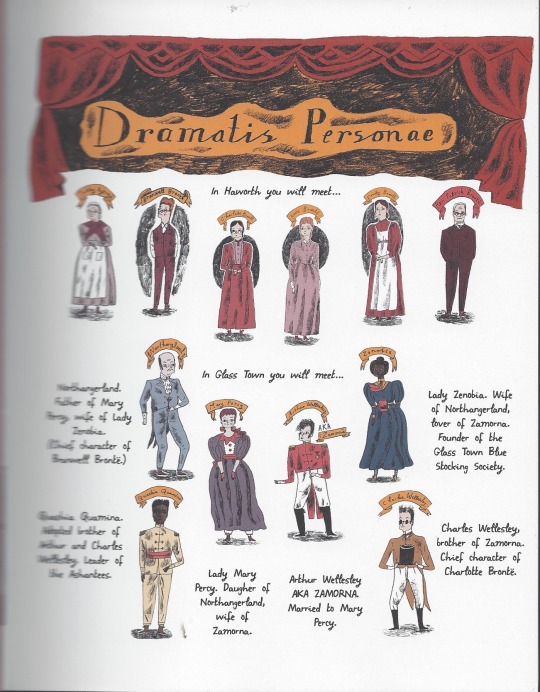
Greenberg’s art in Glass Town is crude in the same way ND Stevenson’s and Gus Allen art work is. If anything it’s more childlike and inconsistent. I don’t love it, but I like how the lines work the limited pallet with a lot of dark, cool reds. It hints at the early industrial feel of their time period as well as the harsh climate of their surroundings.
The narrative starts in the aftermath of the the eldest Brontë sisters, Elizabeth and Maria, deaths. The creation of Glass Town is an escape from the trauma of their final illnesses at a poorly kept boarding school.
Charlotte narrates her tale of Glass Town, to a minor character from her stories who appears as her imaginary friend. They talk through the plot she worked on, which as presented here seems more related to Wuthering Heights than Charlotte’s actual novels. The story includes how while the children started sharing Glass Town, they split with Charlotte and Bramwell writing about Angria while Emily and Anne created Gondor. (Less of Emily and Anne’s writing on Gondal survives to the modern day than Charlotte’s work on Angria, hence why less of it is included in either of these accounts.) Probably because of this shared fantasy world with her brother, Charlotte is shocked by his decent into alcoholism while Emily catches early warning signs. It’s a rumination on the building of escapist fantasy in the face of tragedy and the creation of art. I don’t think it entirely works, but it makes me want to get back to reading the Brontë’s and writing about them.
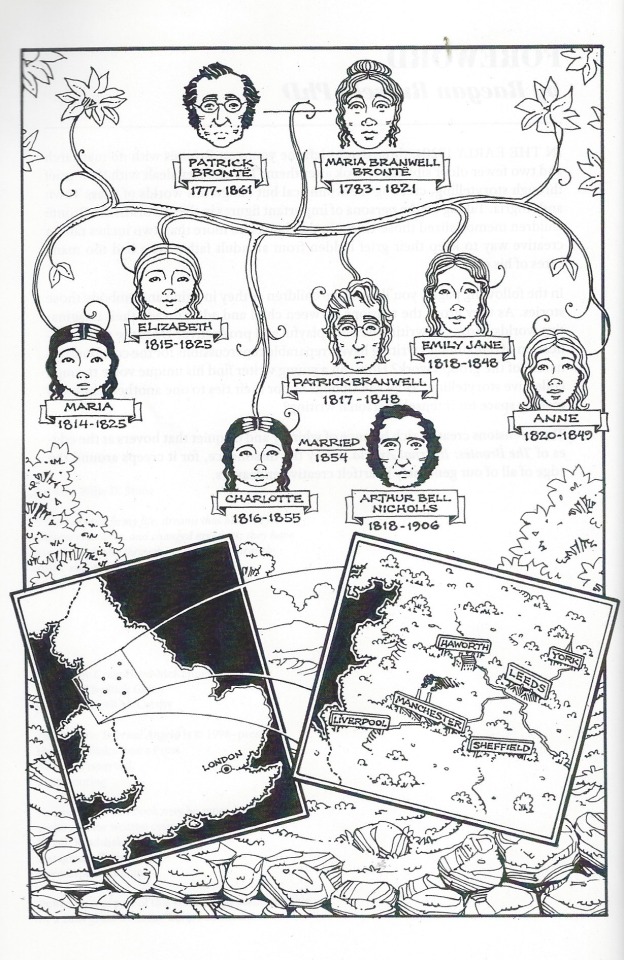
Infernal Angria takes the shared fantasy world and creates an actual portal fantasy. The Brontës literally go between worlds and get used in political machinations in an alternate world’s monarchy. I hated it. The text is something of an apologia for Bramwell for being such a failure. He didn’t really fail, he was manipulated by much more mature people from a world he loved. Also it takes the “artists don’t die, they live through their art” to the extreme of the Brontës didn’t all die at shockingly young ages, they relocated to the other side of a portal. It’s silly and also unclear. It shouldn’t be both. The end had the author talking about his long love of the Brontës as well as a suggested reading list. Everyone in a while you find someone who has some shared enthusiasms but seem to take it in a direction that rubs you wrong.
At first glance, I would think that Geary’s art style is more my type than Greenberg's. But eventually I hated it because the shading was made with a crosshatching that got too easily confused with paterns used for fabrics or wood grains. It’s the shorter of these two books and the one that felt more like a chore to read.
The contrasting treatments of the the worlds of Angria/Glass Town is pretty interesting. The character in both have essentially the same back story, but as presented in Infernal Angria I didn’t feel like the narrative came off as a rough draft of Wuthering Heights. Glass Town treats the alternate world as a reflection on contemporary colonialism, while Infernal Angria approaches it as a pastiche of Medieval fantasy. It makes me wish I had read the source material even more.
Despite finding these books lacking, there will be more comic book takes on the Brontës in my reading future.
#comics#comic books#what i'm reading#Glass Town#The Brontës Infernal Angria#The Brontës#charlotte bronte#Bramwell Brontë#emily bronte#Anne Bronte#Isabel Greenberg#Craig Hurd-McKenney#Rick Geary
3 notes
·
View notes
Photo

Three of Cups. Art by Sarah Shipman, from Our Tarot.
The Brontë Sisters
Charlotte (1816-1855) * England
Emily (1818-1848) * England
Anne (1820-1949) * England
Upright: Sisterhood, friendship, imagination, community Reversed: Exclusion, misunderstanding, sickness
As children, sisters Charlotte, Emily, and Anne Brontë, along with their brother, Branwell, played together by creating expansive fictional worlds and characters. All four were creative; the girls loved writing poetry, and Branwell was a talented visual artist. Together, they created imaginary countries called Gondal and Angria, which served as the settings for the fiction and poetry the siblings wrote in their youth. In 1846, Charlotte, Emily, and Anne published a volume of their poetry called Poems by Currer, Ellis, and Acton Bell. Since women writers were often met with prejudice during this time, they used pseudonyms to obscure their gender but preserved their initials. The book sold only two copies, but it generated positive reviews from critics. One of the purchasers of the volume wrote to the publisher Aylott and Jones, requesting the autographs of the Bell "brothers." He received a slip of paper bearing the sisters' signed pen names...
#Sarah Shipman#Our Tarot#Three of Cups#Three#Cups#Minor Arcana#Tarot#Charlotte Bronte#Emily Bronte#Anne Bronte
25 notes
·
View notes
Text
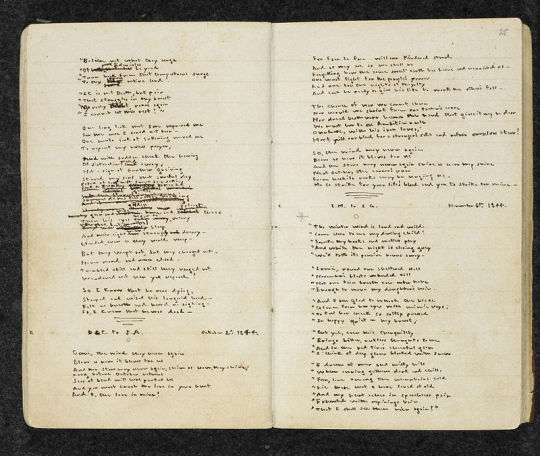
Emily Brontë's manuscript with poems about her childhood fantasy world, Gondal.
An example of such juvenilia is the early work of Branwell, Charlotte, Emily, and Anne Brontë, amazingly well preserved in miniscule diaries and notebooks, in cramped book margins, and on tiny scraps of paper, on which they told the elaborate stories of the fictional countries Angria and Gondal. Though these texts were not intended for publication and written in a purposely minute italic script, scholars have often mined the early works of the Brontës to gain insight into the origins of Wuthering Heights, Jane Eyre, and other mature novels.
- Kristen Petrella
1 note
·
View note
Text
tagged by @davidfosterwallaceandgromit to post books I would like to read in 2021!!
a non-exhaustive list:
À l'ombre des jeunes filles en fleurs by Marcel Proust
A History of my Brief Body by Billy-Ray Belcourt
Lucan’s Pharsalia
Loving by Henry Green
Romance in Marseilles by Claude McKay
Orientalism by Edward Said
Tales of Glass Town, Angria, and Gondal by the Brontes
Testosterone Rex: Unmaking the Myths of Our Gendered Minds by Cordelia Fine
Phantasmion by Sara Coleridge
The Emperor’s Babe by Bernardine Evaristo
Catch and Kill by Ronan Farrow
The Epic of Gilgamesh
Le ventre de Paris by Émile Zola
Olive by Dinah Maria Mulock Craik
Midnight’s Children by Salman Rushdie
Marius the Epicurean by Walter Pater
Hitting a Straight Lick With a Crooked Stick by Zora Neale Hurston
whatever Peter Wimsey mysteries I can get my grubby little hands on
I tag @bluemagicks and @sapphicfarmhand and @fuckmaninoff and everyone else in the sexy quark’s gay bar chat, I forget all your URLs, and whoever else wants to
7 notes
·
View notes
Photo
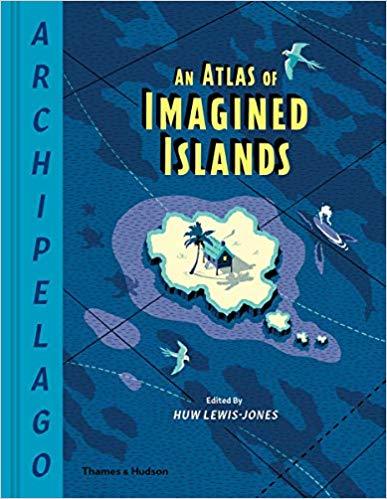
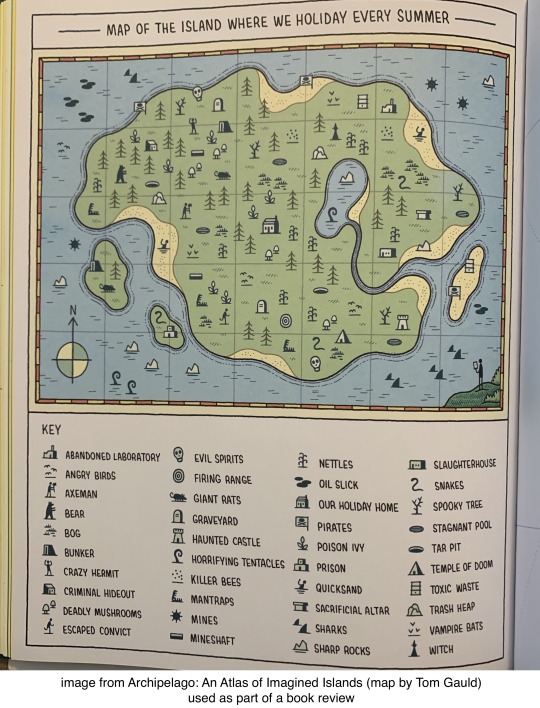
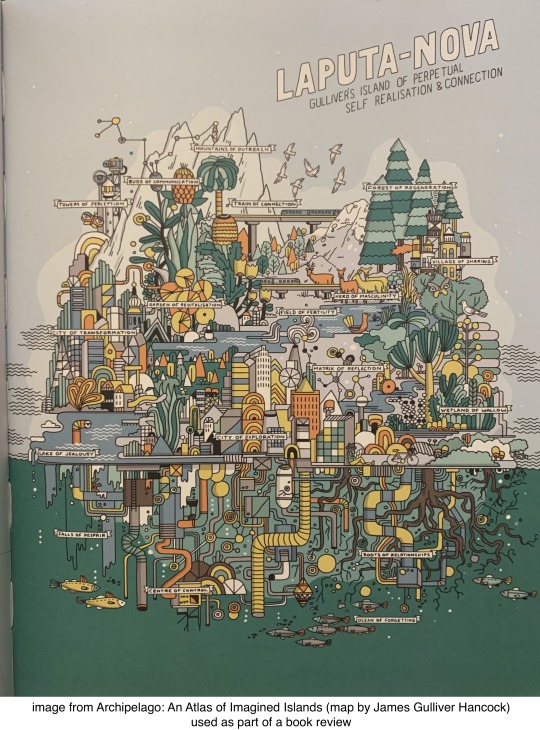
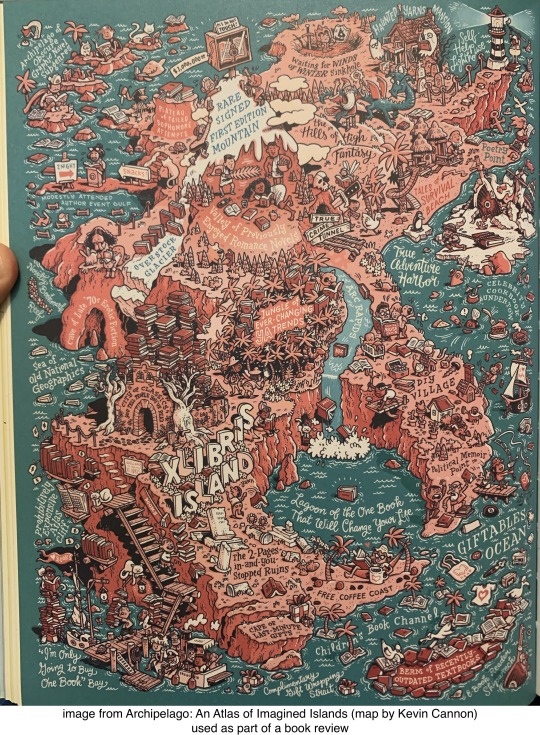
Archipelago: An Atlas of Imagined Islands edited + with an essay titled "Islomania" by Huw Lewis-Jones, prologue by Chris Riddell, 90+ illustrations by almost as many artists. Thames & Hudson, 2019. 9780500022566. 192pp. including notes about each of the contributors. http://www.powells.com/book/-9780500022566?partnerid=34778&p_bt
Each of the island maps in the book is accompanied by a few paragraphs about it. The landscapes are usually beautiful and often bewildering or amusing, and each has its own style. My favorite maps are Xlibris by comics creator Kevin Cannon, who filled his island with stacks of books and locations like Rare Signed First Edition Mountain and Free Coffee Coast. It is, of course, full of happy readers and cats. Graphic novelist Isabel Greenberg's island includes Angria and Gondal, which were invented by the Brontë kids (and I believe are the subject of Greenberg's next book). Illustrator James Gulliver Hancock's Laputa-Nova: Gulliver's Island Of Perpetual Self Realisation & Connection is full of beautiful colors and simple shapes, and seems like a great place to get lost. Yeji Yun's Tipple imagines a far north filled with animals in search of the perfect cocktail.
This is a lovely book to flip through, and the notes on each island are amusing, too. It could serve as a great introduction to different styles of illustration and to the artists' work.
49 notes
·
View notes
Text
Bookhaul September 2020
New books:
Burn
A Sky Painted Gold
Under a Dancing Star
Caught in the Revolution: Petrograd, Russia, 1917
Queen Victoria's Matchmaking: The Royal Marriages that Shaped Europe
Tales of Glass Town, Angria, and Gondal
The Habsburgs: To Rule the World
The Pull of the Stars
Transcedent Kingdom
The Brontës in Brussels
The Ramayana
Sir Gawain and the Green Knight, Pearl and Sir Orfeo
D (A Tale of Two Worlds)
A Book of Secrets
Phoenix Unbound
Dragon Unleashed
Secondhand books:
Former People
Library books: -
5 notes
·
View notes
Text
¡Cuán claro ella brilla!, Emily Brontë
¡Cuán claro ella brilla! Cuán silenciosa Me acuesto bajo su luz protectora; Mientras el Cielo y la Tierra me susurran: Mañana despierta pero sueña esta noche. ¡Sí, ven, mi galante, mi mágico amor! Estas vibrantes sienes se besan tiernamente; Y lleva mi solitario lecho a lo alto, Y dame paz, dame toda la dicha. El mundo huye: ¡oscuro mundo, adiós! Amargo mundo, ocúltate hasta el amanecer, El corazón que no has podido someter Aún ha de resistir, mientras ausente vagas. Tu amor yo nunca, nunca compartiré. Tu odio sólo despierta una sonrisa; Tus lamentos podrán herir, Tus errores podrán llorar; ¡Pero tus mentiras jamás cautivarán! Mientras observaba las estrellas brillando En ese mar apacible, sobre mí, Ansié con fe que todas las aflicciones Del universo sepan, y se celebren en ti. Este será mi sueño nocturno. Pienso que el cielo de esferas gloriosas Recorre su curso luminoso, Cubierto de eternas dichas A través de interminables años. Pienso que no hay otro mundo allí arriba Más lejano que aquel que contemplan estos ojos, Donde la sabiduría nunca se burló del amor, Donde la virtud nunca se sometió a la Infamia.
Se trata de uno de los mejores poemas de Emily Brontë. Si bien es parte de una mitología colectiva creada junto a sus hermanas, donde se relatan las aventuras y desgracias de los reinos de Gondal, Angria y Gaaldine, ¡Cuán claro ella brilla! posee elementos muy personales que ponen de manifiesto la intensidad y la pasión de los sentimientos de Emily Brontë. Tratando de eludir los prejuicios de la época cada una de las hermanas Brontë debió asumir un seudónimo masculino para la publicación de esta excelente colección de poemas, conservando al menos las iniciales de sus verdaderos nombres: Ellis Bell (Emily Brontë), Currer Bell (Charlotte Brontë) y Acton Bell (Anne Brontë).
#poesia#emily bronte#poesia feminista#feminista#feminismo#poetry#feminist poetry#feminist#spanishhpfakes#shpf#julien verlaine
6 notes
·
View notes
Text
Some things I have learned about Emily Bronte due to my recent obsession with her entire family:
- Emily was extremely introverted and sometimes could not even speak in public. She only really spoke freely to her immediate family (I’m including their old servant Tabby because she was family to them)
- She and her sister Anne were like twins. While the older siblings, Charlotte and Branwell, started developing their fantasy world of Angria, Emily and Anne developed Gondal. They would all write about and act out events in these fantasy worlds well into their adult years.
- Emily was devoted to animals of all kinds and was very open about the fact that she preferred them to people. She even rescued a hawk on the Haworth moor and kept him as a pet along with her dogs. His name was Merlin.
- Actually she loved animals so much that it was almost dangerous, as she once got too close to a rabid dog and it bit her
- Emily was quite tough and even more stubborn. When she was bitten by the rabid dog she went straight home and cauterized the wound herself without a word. She contracted tuberculosis in 1848 but insisted upon carrying on as normal, wouldn’t lie down, and refused to see a doctor until just a few minutes before she died.
- Her father owned a pistol that she enjoyed shooting. Apparently she was pretty good at it because he said she shot as well as a man.
- Wuthering Heights is as creepy as it is because Emily took a particular liking to ghost stories and folktales from childhood. She and her siblings were all interested in the supernatural and liked to freak out poor Tabby.
50 notes
·
View notes
Text
"Unlike Tolkien, the Brontës are not known for their contribution to genre fiction, but they may not be a part of Die for the work they did as writers but as players. Tolkien was the historian of his world, but the Brontës were both the characters and the gods of the worlds they created. More than that, they were gods in the style of the Greek pantheon, squabbling and petty and actively involved, killing off each other’s favorites and then bringing their own back to life, and their games about Glass Town, Gondal, and Angria were collaborative in the way that Tolkien’s exhaustive world-building was not."
There's probably going to be a lot about the Tolkien in DIE #3, but she writes about the Brontës and it's going to be significant.
#diecomic#diecomic spoilers#kieron gillen#stephanie hans#charlotte bronte#emily bronte#anne bronte#tolkien#refverential
10 notes
·
View notes
Text
‘‘Perhaps the most well-known example is that of the imaginary “Glass Town Federation” created by the four Brontë siblings—Charlotte, Branwell, Emily, and Anne. This imaginary world consisted of the kingdoms of Angria (invented by Branwell and Charlotte) and Gondal (invented by Emily and Anne), ruled within the capital city of Glass Town. The Brontë children drew maps, invented characters, and wrote stories about these imaginary worlds, naming themselves the gods (“genii”) of the kingdoms.’’
-The British Library. The Brontës’ secret science fiction stories. (2011, May 11).
1 note
·
View note
Text
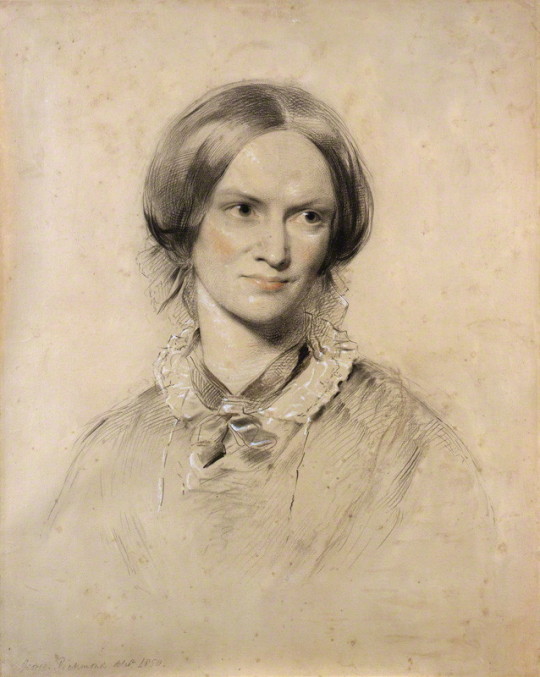
ABR - 21 - (AÑO 1816) - UN DÍA COMO HOY – NACÉ CHARLOTTE BRONTÉ, ESCRITORA BRITÁNICA, F.
Charlotte Brontë, nació en Thornton, Yorkshire; el 21 de abril de 1816 y falleció en Haworth, Yorkshire; 31 de marzo de 1855, fue una novelista inglesa, hermana de las también escritoras Anne y Emily Brontë.
Charlotte Brontë nació en el pueblo de Thornton, Yorkshire, Reino Unido, hija de Patrick Brontë, un clérigo de origen irlandés también escritor, inteligente, austero, maniático, de fuerte carácter, conservador y profundamente enamorado de su mujer, María Branwell y sus hijos.
Charlotte tuvo cinco hermanos: Emily Brontë, Anne Brontë, María, Elizabeth y Branwell. En 1820, su padre fue nombrado rector del hoy famoso Haworth, pueblo de los páramos de Yorkshire, donde la familia se trasladó a vivir.
La madre de Charlotte murió el 23 de septiembre de 1821 y, en agosto de 1824, Charlotte y Emily fueron enviadas con sus hermanas mayores, María y Elizabeth, al colegio de Clergy Daughters, en Cowan Bridge (Lancashire), donde cayeron enfermas de tuberculosis. En este colegio se inspiró Charlotte Brönte para describir la siniestra Lowood que aparece en su novela Jane Eyre. María y Elizabeth volvieron enfermas a Haworth y murieron de tuberculosis en 1825. Por este motivo y por las pésimas condiciones del colegio, la familia sacó a Charlotte y a Emily del internado.
Desde entonces su tía Elizabeth Branwell, se encargó de cuidarlas. Estimuladas por la lectura del Blackwood's Magazine que recibía su padre, desde 1827 las hermanas y el hermano empezaron a imaginar la fantástica confederación de Glass Town, un mundo imaginario para el que continuamente fraguaban historias de los reinos imaginarios de Angria, de Charlotte y Branwell, y Gondal, propiedad de Emily y Anne. De las crónicas de Angria se conservan muchos cuadernos, pero de Gondal ninguno.
En mayo de 1846 publicaron las tres hermanas una colección conjunta de Poemas bajo los seudónimos de Currer, Ellis y Acton Bell. A pesar de todo decidieron seguir escribiendo y probaron a publicar novelas. La primera que se publicó fue Jane Eyre (1847), de Charlotte, también con el seudónimo de Currer Bell, y tuvo un éxito inmediato. Agnes Grey, de Anne, y Cumbres Borrascosas,
Jane Eyre es una novela escrita por Charlotte Brontë, publicada en 1847 por Smith, Elder & Company, que en el momento de su aparición consiguió gran popularidad, encumbrando a la autora como una de las mejores novelistas románticas, y es hoy considerada un clásico de la literatura en lengua inglesa.
Cumbres Borrascosas, es la única novela de Emily Brontë. Fue publicada por primera vez en 1847 bajo el seudónimo de Ellis Bell. Su hermana Charlotte editó una segunda edición póstuma.
Aunque ahora se considera un clásico de la literatura inglesa, el recibimiento inicial de Cumbres Borrascosas fue tibio en el mejor de los casos. Su estructura innovadora, que se suele comparar con un conjunto de muñecas de matryoshka, desconcertó a los críticos en un primer momento. Algunos críticos contemporáneos a la autora incluso pensaron que este era un trabajo anterior, menos maduro, de Charlotte Brontë (que había publicado Jane Eyre ese mismo año bajo el seudónimo de Currer Bell).
Cumbres Borrascosas ha dado lugar a muchas adaptaciones, incluyendo varias películas, dramatizaciones radiofónicas y televisivas, un musical, telenovelas y canciones. Revista Literatura Universal – [email protected]
0 notes
Text
The Brontes: Infernal Angria by Craig Hurd-McKenney and Rick Geary
The Brontes: Infernal Angria by Craig Hurd-McKenney and Rick Geary
In our timeline, the Bronte siblings created several fictional worlds — they started with Glass Town, which grew (mostly from Charlotte and Branwell) into the somewhat separate Angria, while younger siblings Emily and Anne invented the entirely separate land of Gondal. All of those were explicitly set in odd, “exotic” corners of the real world they were familiar with, and peopled with various…
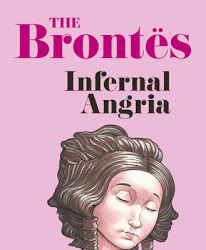
View On WordPress
0 notes
Text
À la découverte d’une famille littéraire assez exceptionnelle... (Partie 3/3)
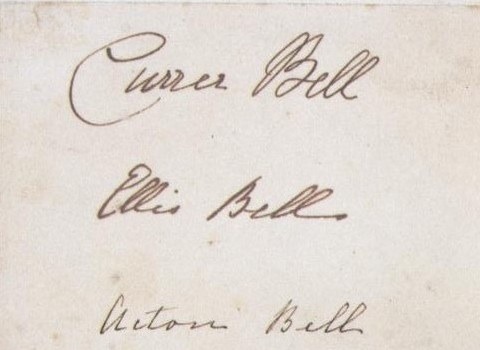
En 1845, Charlotte découvre par hasard les poèmes d’Emily. Elle est subjuguée, et tente de la convaincre de les publier. Anne montre les siens ; très vite, les trois sœurs sélectionnent leurs poèmes — plusieurs seront piochés parmi leurs poésies de Gondal et Angria. Une fois les pièces sélectionnées, Charlotte se met en quête d’un éditeur. C’est finalement Aylott & Jones qui acceptera de les publier, mais uniquement à compte d’auteur. Poems de Currer, Ellis et Acton Bell paraissent en 1846. (C’est Emily qui a insisté pour qu’elles utilisent des pseudonymes.) À la fin de l’année, Charlotte annonce aux éditeurs que chacun(e) des Bell a terminé un roman : Le Professeur pour Charlotte/Currer, Wuthering Heights pour Emily/Ellis, et Agnes Grey pour Anne/Acton. Wuthering Heights et Agnes Grey sont acceptés par l’éditeur Newby, mais Le Professeur est rejeté. La même année, alors qu’elle accompagne son père qui se fait opérer de la cataracte, Charlotte commence Jane Eyre. Elle le propose cette fois à l’éditeur Smith, Elder & Co., qui l’accepte.
En 1847, les trois romans sont publi��s. Jane Eyre connaît un succès retentissant. En 1848, il connaît sa troisième édition tandis qu’Anne publie La Recluse de Wildfell Hall. Cependant, Newby a vendu le manuscrit à un confrère américain, en faisant croire qu’il s’agissait d’une autre œuvre du célèbre Currer Bell. Anne et Charlotte partent pour Londres afin de dissiper tout malentendu, et de prouver que les trois frères Bell sont bel et bien trois, et surtout... trois sœurs.
Quelques mois plus tard, Branwell, rongé par l’alcool, l’opium et la tuberculose, meurt. Fin 1848, Emily tombe à son tour malade, et rejoint son frère sous terre le 19 décembre. En janvier 1849, c’est au tour d’Anne de tomber malade. En mai, pensant qu’un changement d’air lui ferait du bien, Charlotte et son amie Ellen Nussey partent avec Anne au bord de la mer, à Scarborough. Anne y décède le 28.
« Tout est fini. Branwell — Emily — Anne ont passé comme autant de rêves. »
Charlotte rentre à Haworth, seule survivante de la fratrie Brontë. En proie à une violente dépression, elle termine malgré tout son roman Shirley. En 1852, elle commence Villette, un roman autobiographique inspiré de son expérience à Bruxelles. La même année, Arthur Bell Nicholls, le vicaire de Patrick Brontë, la demande en mariage. Patrick réagit violemment, et Charlotte écrit une lettre de refus à Arthur. En 1853, ce dernier démissionne. Plus tard, Charlotte entreprendra une correspondance avec lui... avant de décider de le revoir. Ils se marient en 1854. En 1855, Charlotte, enceinte, tombe malade. Elle meurt le 31 mars.
Au cours de ces trois billets, j’ai essayé de résumer tant bien que mal la vie de la famille Brontë. Si tu es intéressé(e) et que tu veux en savoir plus, je te conseille trois biographies : Les Brontë de Jean-Pierre Ohl, Les sœurs Brontë. La force d’exister de Laura El Makki, et Emily Brontë. Une vie, de Denise Le Dantec.
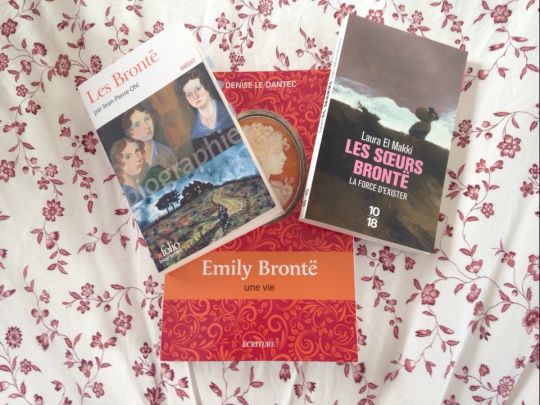
Quant à leurs romans, tu peux notamment les retrouver en édition Archipoche. En 2018, ils les ont tous réédités dans une édition collector, avec des couvertures magnifiques. Je te conseille vivement Jane Eyre, Wuthering Heights, et La Recluse de Wildfell Hall.
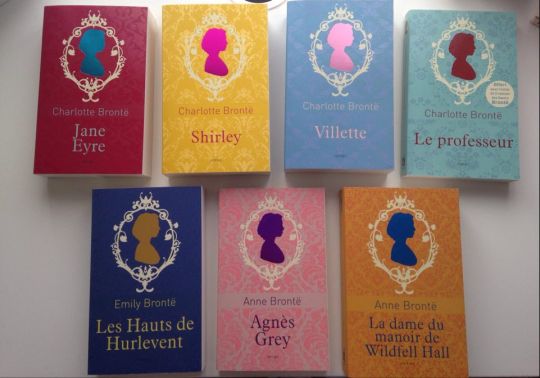
Bonne lecture !
1 note
·
View note